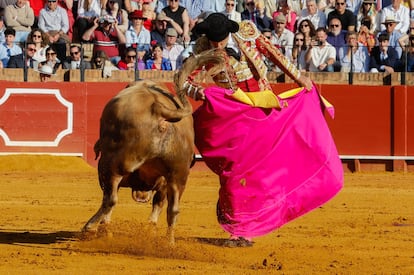No one can understand the bull

Informative text with interpretation

It's not easy to understand a bull's behavior. Today, for example, Santiago Domecq 's bullfight was a clear example of this difficulty. The first bull burst swiftly out of the pens, galloping briskly, came at the horse twice and pushed bravely. He demonstrated drive and extraordinary eagerness with the banderillas, but he reached the muleta out of breath, and the great expectation created turned into profound disappointment. The second bull, the opposite. He was tame on horseback, cornered himself in the middle of the second section, and waited leisurely for the banderilleros, but, my friend, when he saw Perera's muleta, he pursued it tirelessly, with determination, aggressiveness, and promptness. So much so that the audience, stunned by such lively behavior, granted him a lap of the ring that the bull didn't deserve.
By the way, Miguel Ángel Perera performed what is known as a great performance on that bull. High first, with his shoes firmly fixed on the sand, in a sequence of six passes and one more with his chest, full of emotion. Perera responded to the bull's aggressiveness, steadiness, and promptness with bullfighting that brimmed with control, firmness, and depth, so that the first three series of passes with his right hand were dazzling; then another series of long and beautiful natural passes, perfectly linked. But he didn't want to end there, and continued with another series with his right hand, and circular passes that took the performance to a lesser level. Then, there was a tangle with the sword, two warnings were heard, and everything went black.
Escribano, for his part, waited for his first bull on his knees, closer to the hydrant than the second line. The bull appeared like a whirlwind, chasing and seriously challenging his bullfighter. He charged joyfully and vigorously toward Juan Francisco Peña's horse and galloped off in a brilliant third of banderillas from the matador. Escribano presented his performance to the crowd, with excitement sky-high. A great performance was expected, but the animal showed the strain and was no longer the same. The performance had begun with two tight passes exchanged behind the back, and everything suggested something that, later, did not materialize. The bullfighter tried his best; the passes were long and measured, but lacked emotion. And the joy vanished.
After Perera's failure with the sword, the bullfight declined in tone. Neither Borja Jiménez with the third bull nor his companions with their second bulls achieved glory with bulls of noble behavior and a lack of caste. Escribano's performance with the fourth bull showed flashes of aesthetic appeal but lacked vibrancy; the third, Borja's first, lacked transmission, with a touch of dullness in his charge, and Perera once again demonstrated skill and good manners against the standing fifth.
But the sixth bull was announced. Borja went to greet him on his knees in the middle with a long exchange and passionate verónicas and chicuelinas. Once again, excitement reigned. The bull hooked the horse's chest, and Plácido Sandoval had to summon his experience to avoid the dust. He was only able to perform two puyazos, but he received a long applause.
The matador, kneeling once again, placed himself with muleta in hand. The low passes and the two subsequent right-handed passes were full of courage and desire for triumph, but lacked serenity. Well positioned throughout, with the suerte loaded, Jiménez was unable to complete a triumphant façade despite his demonstrated interest.
Bulls from Santiago Domecq, well presented and varied in their play; the first was brave and full of strength; the second was tame and well-bred, and was given a lap of the ring; the third was uneven in the lances, noble, and lacking in transmission; the fourth was meek, gentle, and timid; the fifth was lacking in caste; and the sixth was brash and well-bred.
Manuel Escribano: jab and rear thrust (silence); jab and falling thrust (silence).
Miguel Ángel Perera: thrust (warning), two descabellos (second warning), and three descabellos (applause); rear thrust (silence).
Borja Jiménez: a stab, a half-lying attack (warning), and two descabellos (silence); a stab and a thrust (applause).
Plaza de La Maestranza. May 6. Eleventh bullfight of the April Fair. Almost full.

He has been a bullfighting contributor for EL PAÍS since 1992. He was born in Seville and studied Information Sciences in Madrid. He has worked at El Correo de Andalucía and the Andalusian Business Confederation (CEA). He has published two books on bullfighters Pepe Luis Vargas and Pepe Luis Vázquez.
EL PAÍS


%3Aformat(jpg)%3Aquality(99)%3Awatermark(f.elconfidencial.com%2Ffile%2Fbae%2Feea%2Ffde%2Fbaeeeafde1b3229287b0c008f7602058.png%2C0%2C275%2C1)%2Ff.elconfidencial.com%2Foriginal%2Fd11%2F34b%2F0c5%2Fd1134b0c5ccdb60620e4a902baf06363.jpg&w=3840&q=100)
%3Aformat(jpg)%3Aquality(99)%3Awatermark(f.elconfidencial.com%2Ffile%2Fbae%2Feea%2Ffde%2Fbaeeeafde1b3229287b0c008f7602058.png%2C0%2C275%2C1)%2Ff.elconfidencial.com%2Foriginal%2F9a6%2F56d%2Ff2d%2F9a656df2de9f19fd003b5d2521193cb6.jpg&w=3840&q=100)
%3Aformat(jpg)%3Aquality(99)%3Awatermark(f.elconfidencial.com%2Ffile%2Fbae%2Feea%2Ffde%2Fbaeeeafde1b3229287b0c008f7602058.png%2C0%2C275%2C1)%2Ff.elconfidencial.com%2Foriginal%2F3cd%2F4cd%2F46f%2F3cd4cd46f64fa9a4129f021e0f445d14.jpg&w=3840&q=100)
%3Aformat(jpg)%3Aquality(99)%3Awatermark(f.elconfidencial.com%2Ffile%2Fbae%2Feea%2Ffde%2Fbaeeeafde1b3229287b0c008f7602058.png%2C0%2C275%2C1)%2Ff.elconfidencial.com%2Foriginal%2F9ee%2Fa89%2F7eb%2F9eea897eb53b0b5f7fe73fe837ef508a.jpg&w=3840&q=100)